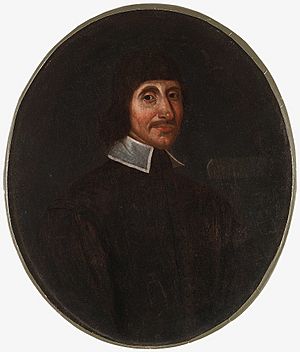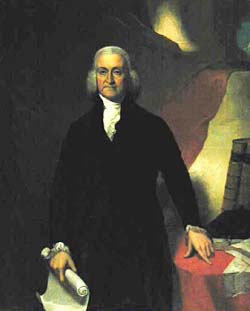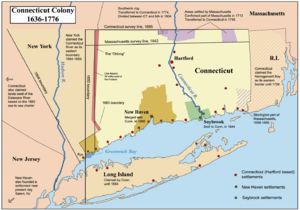List of colonial governors of Connecticut facts for kids
The land that is now the state of Connecticut was first settled by Europeans in the 1620s. Dutch traders set up places to trade goods along the Connecticut River. English settlers, mostly Puritans escaping unfair treatment in England, started arriving in the 1630s. They created several different colonies.
The first colony was the Saybrook Colony, started in 1635 at the mouth of the Connecticut River. Then came the Connecticut Colony, which began settling in 1633 and formed its government in 1639. The New Haven Colony was settled in 1638 and got its government in 1639.
The Saybrook Colony joined the Connecticut Colony in 1644. The New Haven Colony also became part of Connecticut between 1662 and 1665. This happened after the Connecticut Colony received a special document from the King of England called a royal charter.
The Connecticut Colony was one of only two colonies that kept its own governor during the American Revolution. The last colonial governor, Jonathan Trumbull, became Connecticut's first governor as an independent state in 1776.
Contents
Saybrook Colony: 1635–1644
The Saybrook Colony was started in late 1635. It was located at the mouth of the Connecticut River in what is now Old Saybrook, Connecticut. John Winthrop the Younger established it. He was the son of Massachusetts Bay Colony founder John Winthrop.

John Winthrop the Younger was chosen as governor by the first settlers. These settlers included George Fenwick and Lion Gardiner. They said they owned the land because of a special paper from Robert Rich, 2nd Earl of Warwick. The colony was named after two important Puritans, Lords Saye (William Fiennes, 1st Viscount Saye and Sele) and Brooke (Robert Greville, 2nd Baron Brooke). They were the main people who invested money in the colony.
The Saybrook Colony was mostly just one small community. George Fenwick became its real governor when he arrived. He was the only person who signed the land paper to actually live there. In 1644, Fenwick gave the right to govern to the growing Connecticut Colony. There were some arguments about land rights after this transfer. Fenwick went back to England to fight in the English Civil War. Winthrop continued to be active in Connecticut's government.
| # | Governor | Took office | Left office |
|---|---|---|---|
| 1 |  John Winthrop the Younger |
1635 | 1639 |
| 2 | George Fenwick | 1639 | 1644 |
New Haven Colony: 1639–1665
The New Haven Colony was founded by a Puritan named Theophilus Eaton. He thought the rules in the Massachusetts Bay Colony were too relaxed for Puritans. After looking around, he bought land from local Native Americans near the mouth of the Quinnipiac River in 1638.
In 1639, the colony set up its own government. It was similar to the one in the Connecticut Colony. This government called for a new governor to be elected every year. Eaton was elected governor every year until he died in 1658.
After King Charles II returned to the English throne in 1660, he was angry with the New Haven Colony. This was because the colony hid two men who had helped execute his father, Charles I. These men were Edward Whalley and William Goffe.
In 1662, King Charles II gave the Connecticut Colony a royal charter. This charter officially combined the two colonies. The process of joining them together was finished in 1665. The last governor of the New Haven Colony, William Leete, later also served as governor of Connecticut.
| # | Governor | Took office | Left office |
|---|---|---|---|
| 1 | Theophilus Eaton | 1639 | 1658 |
| 2 | Francis Newman | 1658 | 1660 |
| 3 | William Leete | 1661 | 1665 |
Connecticut Colony: 1639–1776

The Connecticut Colony was formed from the towns of Hartford, Windsor, and Wethersfield. Between 1639 and 1655, a governor could not serve two terms in a row. So, the job of governor switched between John Haynes and Edward Hopkins every year. The only exception was in 1642 when George Wyllys served. Thomas Welles and John Winthrop the Younger also served as governors at different times.
John Winthrop the Younger was the governor of the combined Connecticut Colony in 1662. This was the year it received its royal charter from the King. Winthrop stayed in his position and was not re-elected right away. The joining of the colonies took three years to complete. During this time, William Leete remained in New Haven. A similar thing happened to Jonathan Trumbull in 1776. The royal government was replaced by a state government without a new election for governor. This made Trumbull the first governor of the independent state.
Sir Edmund Andros tried to make Connecticut part of the Dominion of New England in 1687. As governor of the Province of New York in the 1670s, he had tried to claim land as far east as the Connecticut River. When he took control of the Dominion in October 1687, he tried to take the colonial charter. This attempt failed at the Charter Oak. Andros is not usually included in the numbered lists of Connecticut governors. However, his picture hangs with other governors in Memorial Hall in Hartford. Since Andros could not take the Connecticut Charter, Connecticut was never fully taken into the Dominion of New England.
| No. | Governor | Term in office | Party | Deputy Governor | |||
|---|---|---|---|---|---|---|---|
| 1 | John Haynes (1594–c. 1653) |
1639 – 1640 |
No party | Roger Ludlow | |||
| 2 | Edward Hopkins (1600–1657) |
1640 – 1641 |
No party | John Haynes | |||
| 3 | John Haynes (1594–c. 1653) |
1641 – 1642 |
No party | George Wyllys | |||
| 4 | George Wyllys (1590–1645) |
1642 – 1643 |
No party | Roger Ludlow | |||
| 5 | John Haynes (1594–c. 1653) |
1643 – 1644 |
No party | Edward Hopkins | |||
| 6 | Edward Hopkins (1600–1657) |
1644 – 1645 |
No party | John Haynes | |||
| 7 | John Haynes (1594–c. 1653) |
1645 – 1646 |
No party | Edward Hopkins | |||
| 8 | Edward Hopkins (1600–1657) |
1646 – 1647 |
No party | John Haynes | |||
| 9 | John Haynes (1594–c. 1653) |
1647 – 1648 |
No party | Edward Hopkins | |||
| 10 | Edward Hopkins (1600–1657) |
1649 – 1650 |
No party | Roger Ludlow | |||
| 11 | John Haynes (1594–c. 1653) |
1650 – 1651 |
No party | Edward Hopkins | |||
| 12 | Edward Hopkins (1600–1657) |
1651 – 1652 |
No party | John Haynes | |||
| 13 | John Haynes (1594–c. 1653) |
1652 – 1653 |
No party | Edward Hopkins | |||
| 14 | Edward Hopkins (1600–1657) |
1653 – 1654 |
No party | John Haynes | |||
| 15 | John Haynes (1594–c. 1653) |
1654 – 1655 |
No party | Edward Hopkins | |||
| 16 | Edward Hopkins (1600–1657) |
1655 – 1656 |
No party | Thomas Welles | |||
| 16 | Thomas Welles (c. 1594–1660) |
1655 – 1656 |
No party | John Webster | |||
| 17 | John Webster (c. 1590–1661) |
1656 – 1657 |
No party | Thomas Welles | |||
| 18 |  |
John Winthrop the Younger (1606–1676) |
1657 – 1658 |
No party | Thomas Welles | ||
| 19 | Thomas Welles (c. 1594–1660) |
1658 – 1659 |
No party | John Winthrop the Younger
John Mason |
|||
| 20 |  |
John Winthrop the Younger (1606–1676) |
1659 – 1676 |
No party | John Mason | ||
| 21 | William Leete (c. 1612–1683) |
1676 – 1683 |
No party | Robert Treat | |||
| 22 |  |
Robert Treat (1624–1710) |
1683 – 1698 |
No party | James Bishop
William Jones |
||
| 23 |  |
Fitz-John Winthrop (1637–1707) |
1698 – November 27, 1707 |
No party | Robert Treat | ||
| 24 |  |
Gurdon Saltonstall (1666–1724) |
1708 – September 20, 1724 |
No party | Nathan Gold | ||
| 25 | Joseph Talcott (1669–1741) |
1724 – October 11, 1741 |
No party | Jonathan Law | |||
| 26 |  |
Jonathan Law (1674–1750) |
1741 – November 6, 1750 |
No party | Roger Wolcott | ||
| 27 | Roger Wolcott (1679–1767) |
1750 – 1754 |
No party | Thomas Fitch | |||
| 28 | Thomas Fitch (c. 1699–1774) |
1754 – 1766 |
No party | William Pitkin | |||
| 29 | William Pitkin (1694–1769) |
1766 – October 1, 1769 |
No party | Jonathan Trumbull | |||
| 30 |  |
Jonathan Trumbull (1714–1799) |
October 1, 1769 – October 10, 1776 |
No party | Matthew Griswold | ||
See also
 In Spanish: Anexo:Gobernadores coloniales de Connecticut para niños
In Spanish: Anexo:Gobernadores coloniales de Connecticut para niños


